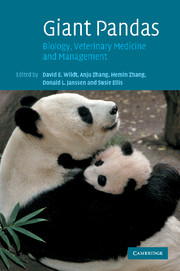Book contents
- Frontmatter
- Contents
- List of contributors
- Foreword
- Acknowledgements
- 1 The giant panda as a social, biological and conservation phenomenon
- 2 The Giant Panda Biomedical Survey: how it began and the value of people working together across cultures and disciplines
- 3 Factors limiting reproductive success in the giant panda as revealed by a Biomedical Survey
- 4 Significant medical issues and biological reference values for giant pandas from the Biomedical Survey
- 5 Life histories and behavioural traits as predictors of breeding status
- 6 Nutrition and dietary husbandry
- 7 Male reproductive biology in giant pandas in breeding programmes in China
- 8 Endocrinology of the giant panda and application of hormone technology to species management
- 9 The value and significance of vaginal cytology
- 10 Parentage assessment among captive giant pandas in China
- 11 The science of behavioural management: creating biologically relevant living environments in captivity
- 12 Evaluating stress and well-being in the giant panda: a system for monitoring
- 13 The neonatal giant panda: hand-rearing and medical management
- 14 Consequences of early rearing on socialization and social competence of the giant panda
- 15 Medical management of captive adult and geriatric giant pandas
- 16 Diseases and pathology of giant pandas
- 17 Ultrasonography to assess and enhance health and reproduction in the giant panda
- 18 Gastrointestinal endoscopy in the giant panda
- 19 Historical perspective of breeding giant pandas ex situ in China and high priorities for the future
- 20 Role and efficiency of artificial insemination and genome resource banking
- 21 Analysis of demographic and genetic trends for developing a captive breeding masterplan for the giant panda
- 22 Partnerships and capacity building for securing giant pandas ex situ and in situ: how zoos are contributing to conservation
- Index
- Plate Section
- References
6 - Nutrition and dietary husbandry
Published online by Cambridge University Press: 09 August 2009
- Frontmatter
- Contents
- List of contributors
- Foreword
- Acknowledgements
- 1 The giant panda as a social, biological and conservation phenomenon
- 2 The Giant Panda Biomedical Survey: how it began and the value of people working together across cultures and disciplines
- 3 Factors limiting reproductive success in the giant panda as revealed by a Biomedical Survey
- 4 Significant medical issues and biological reference values for giant pandas from the Biomedical Survey
- 5 Life histories and behavioural traits as predictors of breeding status
- 6 Nutrition and dietary husbandry
- 7 Male reproductive biology in giant pandas in breeding programmes in China
- 8 Endocrinology of the giant panda and application of hormone technology to species management
- 9 The value and significance of vaginal cytology
- 10 Parentage assessment among captive giant pandas in China
- 11 The science of behavioural management: creating biologically relevant living environments in captivity
- 12 Evaluating stress and well-being in the giant panda: a system for monitoring
- 13 The neonatal giant panda: hand-rearing and medical management
- 14 Consequences of early rearing on socialization and social competence of the giant panda
- 15 Medical management of captive adult and geriatric giant pandas
- 16 Diseases and pathology of giant pandas
- 17 Ultrasonography to assess and enhance health and reproduction in the giant panda
- 18 Gastrointestinal endoscopy in the giant panda
- 19 Historical perspective of breeding giant pandas ex situ in China and high priorities for the future
- 20 Role and efficiency of artificial insemination and genome resource banking
- 21 Analysis of demographic and genetic trends for developing a captive breeding masterplan for the giant panda
- 22 Partnerships and capacity building for securing giant pandas ex situ and in situ: how zoos are contributing to conservation
- Index
- Plate Section
- References
Summary
INTRODUCTION
Nutrition involves a series of processes whereby an animal uses items in its external environment to support internal metabolism (Robbins, 1993). The nutrition and consequent nutritional status of an animal are basic to all aspects of health, including growth, reproduction and disease resistance. Thus, appropriate nutrition and feeding are essential to a comprehensive animal management and preventative medicine programme.
The giant panda's obligate dependence upon bamboo as a primary energy and nutrient source has been well described (Sheldon, 1937; Schaller et al., 1985). Many aspects of panda biology are directly related to its adaptations for utilisation of this highly fibrous, low energy density food, thus demonstrating the inseparable influence of nutrition on behaviour, reproduction and other physiological functions. There may be few other species that more effectively illustrate how an understanding of nutritional adaptations helps us interpret the species ecology.
This chapter describes insights into the nutritional adaptations of the giant panda while identifying priority research that will fill gaps in our understanding of these unique abilities. Historical and current strategies on feeding giant pandas in captivity are presented along with recommendations for improving nutrition and dietary husbandry to promote health and feeding behaviours.
ANATOMY, PHYSIOLOGY, GUIDELINES AND ASSESSMENT
Feeding ecology and anatomical adaptations to a herbivorous diet
More than 99% of the food consumed by the free-ranging giant panda consists of bamboo (Schaller et al., 1985). Yet the giant panda is unique in that it has the relatively simple gastrointestinal tract of a carnivore.
- Type
- Chapter
- Information
- Giant PandasBiology, Veterinary Medicine and Management, pp. 101 - 158Publisher: Cambridge University PressPrint publication year: 2006
References
- 8
- Cited by



